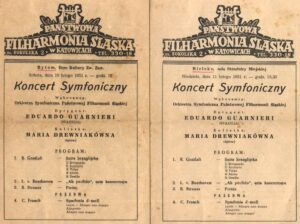- Conductor Eduardo Guarnieri, on tour in the Soviet Union, includes in his repertoire the Suite for large Orchestra, of Radamés Gnattali. A transcription of the Suite for small orchestra, from 1940.
- The 7th School Youth Concert is held at Teatro Rex, in Rio de Janeiro, promoted by the Ministry of Education and Health, with the Brazilian Symphony Orchestra conducted by Leo Peracchi. In the program, the
Brasiliana
[nº 1] (1944), by Radamés Gnattali. - Following the 1950 release, the Continental label releases a second album with 3 discs and 6 songs by Noel Rosa (two in partnership with Vadico and one with Kid Pepe), again in the voice of Aracy de Almeida, with arrangements by Radamés for his orchestra.
- The Sinter label releases the choro
Velvet
by Radamés, interpreted by the ensemble Os Copacabanas. - Lúcio Alves records Sábado em Copacabana, by Dorival Caymmi and Carlos Guinle, with accompaniment by
Vero
and his Orchestra
[1]. - Radamés composes:
-
Concertino nº 1 for guitar and chamber orchestra
– dedicated to Maria Teresa Terán and Juan Antonio Mercadal - Concertino nº 2 for guitar and chamber orchestra [2] – dedicated to Aníbal Augusto Sardinha (Garoto)
Concertino No. 2 for guitar and piano
– (reduction of the orchestral part for piano)
-
- Composer Arnold Schöenberg, creator of dodecaphonism, dies in the USA.
- The newspaper Última Hora, founded by Samuel Wainer, is launched in Rio de Janeiro (RJ).
- In Moscow, writer Jorge Amado receives the Stalin prize.
- Sinter launches the first Long-play, 10-inch vinyl record in Brazil.
- Getúlio Vargas returns from exile, runs for president of the Republic, and is elected president of Brazil, by direct vote, in a democratic election.
- Beginning of the O Petróleo é nosso campaign, with the objective of nationalizing oil extraction and refining in Brazil.







